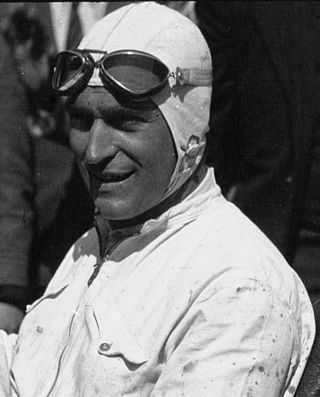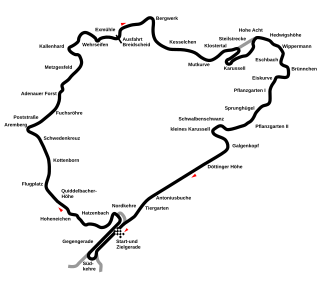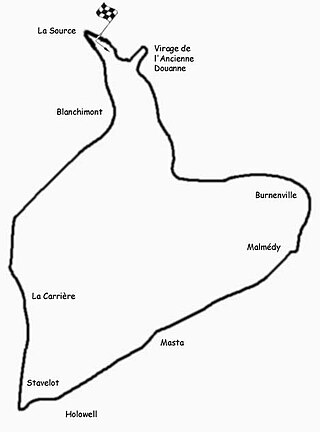
Tazio Giorgio Nuvolari was an Italian racing driver. He first raced motorcycles and then concentrated on sports cars and Grand Prix racing. Originally of Mantua, he was nicknamed il Mantovano Volante and Nuvola ("Cloud"). His victories—72 major races, 150 in all—included 24 Grands Prix, five Coppa Cianos, two Mille Miglias, two Targa Florios, two RAC Tourist Trophies, a Le Mans 24-hour race, and a European Championship in Grand Prix racing. Ferdinand Porsche called him "the greatest driver of the past, the present, and the future".

Enzo Anselmo Giuseppe Maria Ferrari was an Italian motor racing driver and entrepreneur, the founder of the Scuderia Ferrari Grand Prix motor racing team, and subsequently of the Ferrari automobile marque. Under his leadership, Scuderia Ferrari won nine drivers' world championships and eight constructors' world championships in Formula 1 during his lifetime.

Joseph Gilles Henri Villeneuve was a Canadian racing driver, who competed in Formula One from 1977 to 1982. Villeneuve was runner-up in the Formula One World Drivers' Championship in 1979 with Ferrari, and won six Grands Prix across six seasons.

Scuderia Ferrari, currently racing under Scuderia Ferrari HP, is the racing division of luxury Italian auto manufacturer Ferrari and the racing team that competes in Formula One racing. The team is also known by the nickname "The Prancing Horse", in reference to their logo. It is the oldest surviving and most successful Formula One team, having competed in every world championship since 1950.

Achille Varzi was an Italian racing driver. He is remembered as the chief rival of Tazio Nuvolari, and was the winner of the 1933 Monaco Grand Prix.

Luigi Cristiano Fagioli was an Italian racing driver, who competed in Grand Prix motor racing from 1928 to 1949, and Formula One from 1950 to 1951. Nicknamed "The Abruzzi Robber", Fagioli won the 1951 French Grand Prix with Alfa Romeo aged 53, and remains the oldest driver to win a Formula One Grand Prix. Fagioli was runner-up in the European Drivers' Championship in 1935 with Mercedes.

Giancarlo Baghetti was an Italian racing driver, who competed in Formula One from 1961 to 1967. Baghetti won the 1961 French Grand Prix in a privateer Ferrari 156, and remains the only driver to win a Formula One Grand Prix on debut.

Baconin Borzacchini was an Italian racing driver who often competed under the nom de courseMario Umberto Borzacchini.
Ferrari is an Italian company which has produced sports cars since 1947, but traces its roots back to 1929 when Enzo Ferrari formed the Scuderia Ferrari racing team.

The 1936 Grand Prix season was the third year of the 750 kg Formula. The next iteration of the Mercedes-Benz did not prove successful and the team withdrew during the season to instead prepare for the next one. It therefore fell to the resurgent Auto Union team to dominate the racing. In particular, it was their young, new superstar, Bernd Rosemeyer, who mastered the tricky car and who showed superlative skill in wet conditions. Rosemeyer easily won this season's European Championship by winning three of the four Grands Prix.

The 1935 German Grand Prix was a Grand Prix motor race held at the Nürburgring on 28 July 1935.

Guillaume Laurent "Guy" Moll was a French racing driver.
The Belgrade Grand Prix is a former grand prix from the Grand Prix motor racing era - precursor to Formula One. It was held on the streets of Belgrade, the capital of Kingdom of Yugoslavia and Serbia's largest city. Only one championship event was held, on 3 September 1939. This race saw 5 drivers take part - two Mercedes-Benz in their Silver Arrows, two Auto Unions and a Bugatti, which finished 19 laps down - and was won by Tazio Nuvolari. The Kalemegdan Park circuit is no longer operational.

The Alfa Romeo P3, P3 monoposto or Tipo B was a classic Grand Prix car designed by Vittorio Jano, one of the Alfa Romeo 8C models. The P3 is considered to be the world's first genuine single-seat Grand Prix racing car and was Alfa Romeo's second monoposto after the Tipo A monoposto (1931). It was based on the earlier successful Alfa Romeo P2. Taking lessons learned from that car, Jano went back to the drawing board to design a car that could last longer race distances.

The 1935 Grand Prix season was the second year of the new 750 kg Formula. The success of the previous year encouraged the AIACR to reinitiate the European Championship. It was composed of the seven national Grands Prix and was won by Rudolf Caracciola, driving for the Mercedes-Benz team. The team dominated the season winning five of those Grand Épreuves, as well as four of the other major races of the season. However, in one of the great motor-races in sporting history, Tazio Nuvolari in a Scuderia Ferrari Alfa Romeo beat the combined numbers of the German teams in their home Grand Prix. The season also saw the arrival on the international stage of the bright young talent Bernd Rosemeyer in the Auto Union team.

The 1933 Grand Prix season was an intermediate year, as it would be the last season for the current AIACR regulations before a new weight-formula was introduced in 1934. As such, the European Championship was not held and the manufacturers held back on further developments of their existing models. Alfa Romeo, following an Italian government financial bailout and like Mercedes-Benz the previous year, had shut down its Alfa Corse works team. Scuderia Ferrari, their regular customer team took up the role of racing Alfa Romeos and a number of ex-works drivers moved across to join their ranks. They were not allowed, however, to buy the impressive Tipo B that had been so dominant in the previous season.

Autodromo di Modena was a race track on the edge of Modena in Italy. The track had a length of 2.366 km (1.470 mi). It was opened in 1950 and the circuit was crossed by an airstrip of about 1.600 km (0.994 mi) in length which was used by the local flying club.
The 1930 Grand Prix season continued the malaise that had taken over the sport. Although there was little technical advance more privateer teams were forming, getting some factory support. The AIACR continued to mandate its fuel-regulated Formula Libre rules. Across the Atlantic, the AAA abandoned the AIACR regulations. Their new regulations were derisively called the “Junk Formula” by purists, opening up to their own version of Formula Libre: with modified stock-standard cars of up to 366 cu in (6-litres) with two seats.

Eugenio Siena was an Italian racecar driver from Milan.

The 1933 Belgian Grand Prix was a Grand Prix motor race held at Spa-Francorchamps on 9 July 1933. The 40-lap race was won by Tazio Nuvolari, of Scuderia Ferrari, driving a Maserati. Second and third were taken by the works Bugatti drivers Achille Varzi and René Dreyfus.

















